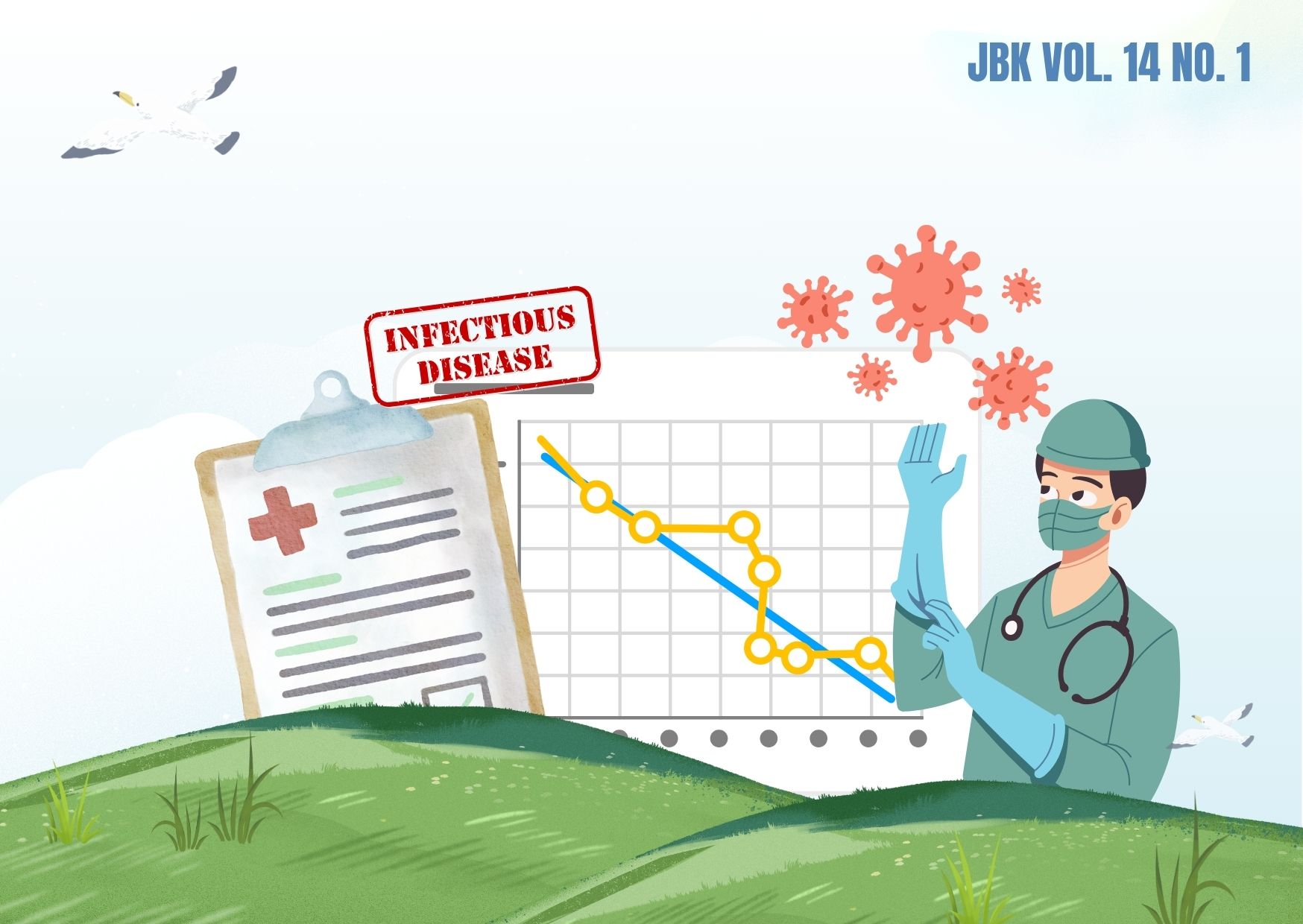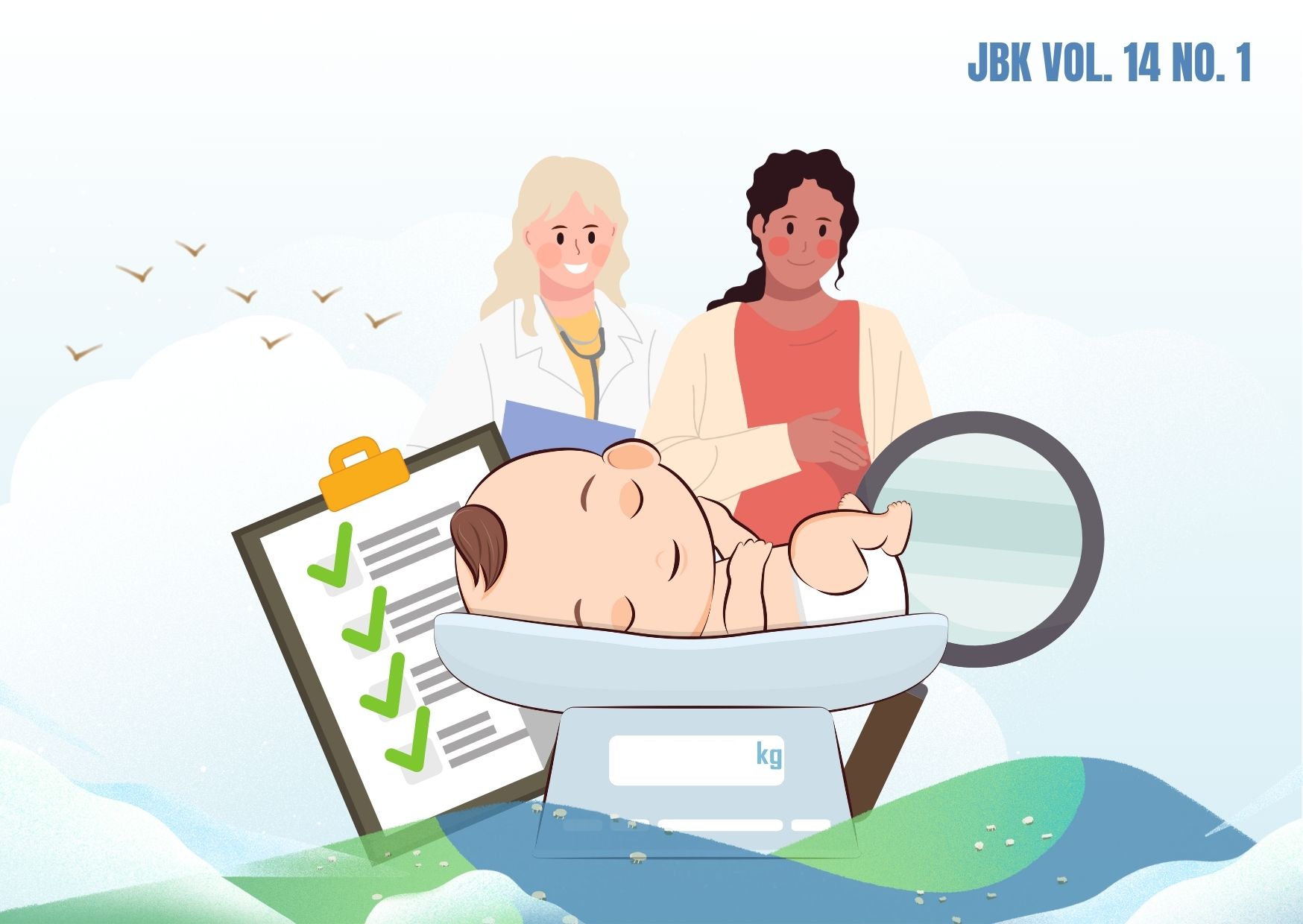THE RELATIONSHIP BETWEEN AGE, EDUCATION LEVEL, AND RESIDENTIAL AREA TOWARDS CONTRACEPTIVE USE IN MARRIED WOMEN IN INDONESIA

Downloads
Indonesia was the fourth most densely populated country in the world with more than 260 million people in 2017. One of the government's efforts to overcome the high rate of population growth is a family planning program by using contraception methods. However, the Contraceptive Prevalence Rate (CPR) for all contraception methods in Indonesia in 2017 was only 63.6%, lower than its target in 2017 which was 65.6%. Several previous studies have shown that there are factors that cause low contraceptive use, such as age, education, and residential area. This study aims to analyze the relationship between age, education level, and residential area with contraceptive use in married women in Indonesia. This study used secondary data from the 2017 IDHS with a cross-sectional design. The sample of this study was married women of 15-49 years old age group, with a total of 35,479 respondents. Data analysis used Chi-square statistical test. The results were the variables of age (p=0.000), education level (p=0.000), and residential area (p=0.008) showed statistically significant results. In conclusion, there are relations between age, education level, and residential area with contraceptive use in married women in Indonesia. Therefore, the coordination of cross-sectoral and cross-program needs to be carried out, such as intensifying the promotion and implementation of family planning programs in the community, socializing education about family planning, and equitable access to family planning services and information throughout Indonesia.
Central Intelligence Agency. The World Factbook ” Country Comparison: Population. CIA Office of Public Affairs. 2017. Available from: https://www.cia.gov/the-world-factbook/field/population/country-comparison
Secretariat Cabinet of Republic of Indonesia. Laju Pertumbuhan Penduduk 1,3 Persen, Pemerintah Kembali Galakkan Program KB. Humas Sekretariat Kabinet RI. 2016. Available from: https://setkab.go.id/laju-pertumbuhan-penduduk-13-persen-pemerintah-kembali-galakkan-program-kb/
Central Bureau of Statistics. Laju Pertumbuhan Penduduk menurut Provinsi. Badan Pusat Statistik. 2020. p. 335–58.
The Ministry of National Development Planning / BAPPENAS, Central Bureau of Statistics, United Nations Fund for Population Activities / UNFPA. Proyeksi Penduduk Indonesia 2010-2035. Katalog Badan Pusat Statistik. Jakarta: Central Bureau of Statistics; 2013. Available from: https://perpustakaan.bappenas.go.id/
Pancasasti R, Khaerunisa E. Analisis Dampak Laju Pertumbuhan Penduduk terhadap Aspek Kependudukan Berwawasan Gender pada Urban Area di Kota Serang. Tirtayasa Ekon. 2018 Apr 30;13(1):130. doi: http://dx.doi.org/10.35448/jte.v13i1.4231
Rochaida E. Dampak Pertumbuhan Penduduk terhadap Pertumbuhan Ekonomi dan Keluarga Sejahtera di Provinsi Kalimantan Timur. Forum Ekon. 2016;18(1):14–24. Available from: https://journal.feb.unmul.ac.id/
Triyastuti D. Pengaruh Kepadatan Penduduk terhadap Kualitas Hidup Masyarakat di Kecamatan Ngemplak Kabupaten Boyolali Tahun 2013 dan 2017. Universitas Muhammadiyah Surakarta; 2019. Available from: https://123dok.com/
Ramadhan MH, Idami Z. Pengendalian Laju Pertumbuhan Penduduk Melalui Program Keluarga Berencana di Kota Banda Aceh. J Gov Soc Policy. 2020;1(1):47–56. Available from: http://www.jurnal.unsyiah.ac.id/GASPOL/article/view/17330
Tatuhe S, Laloma A, Pesoth WF. Peranan Pemerintah Daerah dalam Pengendalian Pertumbuhan Penduduk. J Adm Publik. 2016;1(37). Available from: https://ejournal.unsrat.ac.id/index.php/JAP/article/view/12038
Health Information and Data Center. InfoDATIN: Situasi dan Analisis Keluarga Berencana. Pusat Data dan Informasi Kementerian Kesehatan RI. Jakarta: Pusat Data dan Informasi Kemenkes RI; 2014. Available from: https://pusdatin.kemkes.go.id/
Ewerling F, Victora CG, Raj A, Coll CVN, Hellwig F, Barros AJD. Demand for family Planning Satisfied with Modern Methods among Sexually Active Women in low- And Middle-Income Countries: Who is Lagging Behind?. Reprod Health. 2018;15(1):1–10. Available from: https://reproductive-health-journal.biomedcentral.com/articles/10.1186/s12978-018-0483-x
Sardjoko S. Rencana Kerja Pemerintah Tahun 2019 dan Peran Sentral Program KKBPK dalam Pencapaian Prioritas Nasional. Solo: Deputi Pembangunan Manusia, Masyarakat dan Kebudayaan, Kementerian PPN/Bappenas; 2018.
Suwardono BP, Fatah MZ, Farid NN. Description of the Low Participation of Family Planning Acceptor in Bangkalan Regency. J PROMKES. 2020;8(1):121–31. doi: http://dx.doi.org/10.20473/jpk.V8.I1.2020.121-131
Central Bureau of Statistics. Rata-Rata Lama Sekolah (RLS) Menurut Provinsi dan Jenis Kelamin, 2010-2019. Badan Pusat Statistik. 2020. Available from: https://www.bps.go.id/
Lestari ERP, Kusumawati E, Safaringga H. Deskripsi Faktor yang Mempengaruhi Rendahnya Cakupan Peserta KB Aktif pada Pemantauan Wilayah Setempat Kesehatan Ibu dan Anak (PWS-KIA). Asuhan Kesehat J Ilm Ilmu Kebidanan dan Keperawatan. 2015;6(1):37–9. Available from: http://ejournal.rajekwesi.ac.id/index.php/journal-research-health/article/view/86
Triyanto L, Indriani D. Faktor yang Mempengaruhi Penggunaan Jenis Metode Kontrasepsi Jangka Panjang (MKJP) pada Wanita Menikah Usia Subur di Provinsi Jawa Timur. Indones J Public Heal. 2018;13(2):246–57. doi: http://dx.doi.org/10.20473/ijph.v13i2.2018.246-257
Warmin AE, Multazam A, Arman. Penggunaan Kontrasepsi pada Wanita Menikah Usia Dini di Kec. Gantarang Kab. Bulukumba. J Ilm Kesehat Diagnosis. 2017;11(3):274–8. Available from: http://ejournal.stikesnh.ac.id/index.php/jikd/article/view/770
Central Bureau of Statistics. Pencegahan Perkawinan Anak (Percepatan yang Tidak Bisa Ditunda). Jakarta: Badan Pusat Statistik; 2020. 0–44 p. Available from: https://www.unicef.org/indonesia/media/2851/file/Child-Marriage-Report-2020.pdf
Juwita P, Sugiman, Hendikawati P. Ketepatan Klasifikasi Metode Regresi Logistik dan CHAID dengan Pembobotan Sampel. Prism Pros Semin Nas Mat. 2018;1(3):684–95. Available from: https://journal.unnes.ac.id/sju/index.php/prisma/article/view/20215/9590
Nugroho DN. Kebijakan dan Potensi Daerah Menghadapi Bonus Demografi Menutup. J Kel Berencana. 2019;4(2):47–55. doi: https://doi.org/10.37306/kkb.v4i2.27
Idris H. Factors Affecting the Use of Contraceptive in Indonesia: Analysis from the National Socioeconomic Survey (Susenas). J Masy Health. 2019;15(1):117–23. doi: https://doi.org/10.15294/kemas.v15i1.14098
Agustini R, Wati DM, Ramani A. Kesesuaian Penggunaan Alat Kontrasepsi Berdasarkan Permintaan KB pada Pasangan Usia Subur (PUS) di Kecamatan Puger Kabupaten Jember. e-Jurnal Pustaka Kesehat. 2015;3(1):155–62. Available from: https://jurnal.unej.ac.id/index.php/JPK/article/view/2519
Dewi. Hubungan Usia dan Paritas dengan Penggunaan MKJP pada Akseptor Baru di Puskesmas Lendah 1 Kulon Progo Yogyakarta. FIK Universitas Aisyiyah. Universitas 'Aisyiyah Yogyakarta; 2017. Available from: http://digilib.unisayogya.ac.id/id/eprint/2825
Marcelya S, Salafas E. Faktor Pengaruh Risiko Kehamilan "4T” pada Ibu Hamil. Indones J Midwifery. 2018;1(2):120–7. doi: http://dx.doi.org/10.35473/ijm.v1i2.96
Pratiwi AI. Faktor-Faktor yang Berhubungan dengan Keikutsertaan Pasangan Usia Subur (PUS) dengan Penggunaan Alat Kontrasepsi di Desa Alamendah Kecamatan Rancabali Kabupaten Bandung. J Kebidanan. 2019 Nov 30;8(1):1–11. doi: https://doi.org/10.47560/keb.v8i1.130
Titaley CR, Sallatalohy N. Utilization of Family Planning Contraceptives among Women in the Coastal Area of South Buru District, Maluku, 2017. Natl Public Health Public Heal J. 2020;15(1):40–7. doi: http://dx.doi.org/10.21109/kesmas.v15i1.2542
Agus Y, Pamungkasari EP, Soemanto R. Theory of Planned Behavior: Determinants of the Use of Modern Family Planning Method. J Matern Child Heal. 2019;4(5):369–79. doi: https://doi.org/10.26911/thejmch.2019.04.05.11
Aminatussyadiah A, Prastyoningsih A. Faktor yang Mempengaruhi Penggunaan Kontrasepsi pada Wanita Usia Subur di Indonesia (Analisis Data Survei Demografi dan Kesehatan Indonesia Tahun 2017). J Chem Inf Model. 2019;53(9):1689–99. Available from: https://jurnal.umpp.ac.id/index.php/jik/article/view/167
Herowati D, Sugiharto M. Hubungan Antara Kemampuan Reproduksi, Kepemilikan Anak, Tempat Tinggal, Pendidikan dan Status Bekerja pada Wanita Sudah Menikah dengan Pemakaian Kontrasepsi Hormonal di Indonesia Tahun 2017. Bul Penelit Sist Kesehat. 2019;22(2):91–8. doi: https://doi.org/10.22435/hsr.v22i2.1553
Filmira RL, Fatah MZ. Determinan Keinginan Penerapan Program KB (Keluarga Berencana) pada Remaja Pria Indonesia di Masa Mendatang. J Heal Sci Prev. 2020;4(2):58–67. doi: https://doi.org/10.29080/jhsp.v4i2.384
Zia HK. Hubungan Tingkat Pendidikan, Tempat Tinggal dan Informasi Petugas Lapangan Keluarga Berencana (PLKB) terhadap Unmet Need KB pada Wanita Kawin. Indones J Public Heal. 2019;14(2):150–9. doi: http://dx.doi.org/10.20473/ijph.v14i2.2019.150-159
Barot S. Sexual and Reproductive Health and Rights Are Key to Global Development: The Case for Lean Up Investment. Guttmacher Policy Rev. 2015;18(1):1–7. Available from: https://www.guttmacher.org/sites/default/files/article_files/gpr180101.pdf
Pujihasvuty R. Profil Pemakaian Kontrasepsi: Disparitas Antara Perdesaan dan Perkotaan. J Kependud Indones. 2018;12(2):105–18. Available from: https://ejurnal.kependudukan.lipi.go.id/index.php/jki/article/view/257
Restiyani NLN, Yasa IGWM. Efektivitas Program Kampung Keluarga Berencana (KB) dan Dampaknya Terhadap Kesejahteraan Keluarga Miskin di Kota Denpasar. E-Jurnal Ekon dan Bisnis Univ Udayana. 2019;8(7):711–40. doi: https://doi.org/10.24843/EEB.2019.v08.i07.p03
Mustafa G, Azmat SK, Hameed W, Ali S, Ishaque M, Hussain W, et al. Family Planning Knowledge, Attitude and Practices among Married Men and Women in Rural Areas of Pakistan. International J Reprod Med. 2015;2015(190520):1–8. doi: https://doi.org/10.1155/2015/190520
Copyright (c) 2022 Jurnal Biometrika dan Kependudukan

This work is licensed under a Creative Commons Attribution-NonCommercial-ShareAlike 4.0 International License.
Copyright©2022 Jurnal Biometrika dan Kependudukan (Journal of Biometrics and Population)
This work is licensed under a Creative Commons Attribution-NonCommercial-ShareAlike 4.0 International License.
1. Copyright of all journal manuscripts is held by the Jurnal Biometrika dan Kependudukan.
2. Formal legal provisions to access digital articles of the electronic journals are subject to the provision of the Creative Commons Attribution-ShareAlike license (CC BY-NC-SA), which means that Jurnal Kesehatan Biometrika dan Kependudukan to keep, transfer media/format, manage in the form of databases, maintain, and publish articles.
3. Published manuscripts both printed and electronic are open access for educational, research, and library purposes. Additionally, the editorial board is not responsible for any violations of copyright law.



































